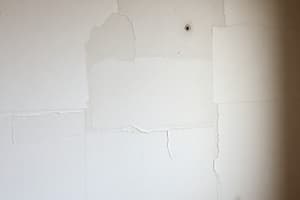Podcast
Questions and Answers
What is the primary function of drywall screws in drywall furring systems?
What is the primary function of drywall screws in drywall furring systems?
- To secure channels to masonry walls
- To hold furring channels together
- To attach drywall to insulation
- To fasten gypsum wallboard to channels (correct)
Which of the following statements about drywall furring channels is correct?
Which of the following statements about drywall furring channels is correct?
- They require splicing plates for installation.
- They have a fastening surface that is 10 inches wide.
- They can be vertically or horizontally erected. (correct)
- They are only attached to wooden studs.
Which advantage does the use of a drywall furring system provide?
Which advantage does the use of a drywall furring system provide?
- The requirement for multiple types of fasteners
- Higher material costs and complex installation
- A range of surface applications including drywall only
- Significantly reduced installation time and material cost (correct)
What characteristic is unique to drywall screws used in furring systems?
What characteristic is unique to drywall screws used in furring systems?
How do metal furring systems accommodate non-plumb walls?
How do metal furring systems accommodate non-plumb walls?
Flashcards
Drywall Furring System
Drywall Furring System
A structural system that creates a space between the wall and the drywall to accommodate insulation and provide a more even surface.
Drywall Screws
Drywall Screws
Used for fastening drywall to the furring channels, they offer superior holding power, and their shape facilitates easy taping.
Study Notes
Drywall Furring Systems
- Drywall furring systems attach drywall to masonry or concrete surfaces.
- Furring channels are 2 inches wide and have 3/8 inch wing flanges.
- Channels are fastened directly to the wall surfaces with self-drilling screws at 12-inch intervals.
- Furring channels can span up to 12-feet.
- They can be placed horizontally or vertically at 24-inch centers.
Drywall Furring System Components
- Furring channels are used to attach drywall to various surfaces.
- Self-drilling drywall screws are the recommended fasteners and will create a dimple in the board.
- The screws feature a Phillips head and a rust-inhibitive coating.
Advantages of Furring Systems
- Furring systems are composed of few components, enabling fast and efficient installation.
- The installation is simple, with simplified procedures.
- Cost is low due to the limited components.
- Installation is quicker than other systems.
- May be used on existing surfaces like plaster, brick, tile, and gypsum tile or monolithic concrete.
Types of Furring Systems
- Metal furring systems consist of drywall furring channels, clincher-type channels, or resilient furring channels.
- These systems are adaptable to irregular walls and ceilings.
- "Hat rack" is an alternative name for the drywall furring channel.
Studying That Suits You
Use AI to generate personalized quizzes and flashcards to suit your learning preferences.




